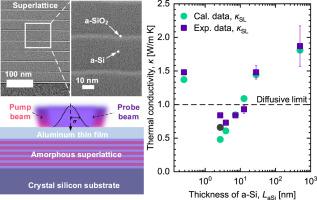Nano Energy ( IF 17.6 ) Pub Date : 2021-02-19 , DOI: 10.1016/j.nanoen.2021.105903 Yuxuan Liao , Sotaro Iwamoto , Michiko Sasaki , Masahiro Goto , Junichiro Shiomi

|
Advanced means to further reduce the thermal conductivity of dense amorphous materials by nanostructuring is important for thermal management in future electronic and optical devices. While the works so far have realized the reduction by scattering propagons, here, we demonstrate that nanostructures can in addition inhibit transport of diffusons, by measuring the thermal conductivity of amorphous-silicon/amorphous-silica superlattices with a periodicity ranging from 4.5 nm to 29.3 nm at room temperature. The measurements show that thermal conductivity of the superlattice with periodicity below 9.5 nm is significantly below the amorphous diffusive limit (~1 W/m K). The measured thermal conductivity can be reproduced using a combination of the phonon-gas kinetics model and Allen-Feldmann theory without any fitting parameters, with the interfacial transmittance of propagons and diffusons obtained by atomistic Green’s function. In addition to the known reduction of propagon transport, the effective mean free paths of diffusons are reduced from that of the bulk (1–3 nm) to several angstroms or even atomistic by extreme boundary scattering at the interfaces in the superlattice, giving rise to a significant tunability of the amorphous thermal conductivity using truly nanoscale structures. The influence of interface scattering on the diffusion transport can be effectively described by the Boltzmann transport equation, and in this sense, propagons and diffusons do not fundamentally differ.
Data and materials availability
All data needed to evaluate the conclusions in the paper are present in the paper and/or the Supplementary Materials. Additional data related to this paper may be requested from the authors.
中文翻译:

非晶超晶格结构中的热扩散低于扩散极限
通过纳米结构进一步降低致密无定形材料热导率的先进方法对于未来电子和光学设备的热管理很重要。尽管迄今为止的工作已经实现了通过散射丙炔而减少的方法,但在这里,我们证明了纳米结构还可以通过测量周期为4.5 nm至29.3的非晶硅/非晶硅超晶格的热导率来抑制扩散子的传输。在室温下为nm。测量结果表明,周期低于9.5 nm的超晶格的热导率显着低于非晶扩散极限(〜1 W / m K)。可以使用声子-气体动力学模型和Allen-Feldmann理论的组合来复制测得的热导率,而无需任何拟合参数,通过原子格林函数获得的丙烷和扩散子的界面透射率。除了已知的减少丙运的方法外,扩散剂的有效平均自由程还通过在超晶格界面处的极端边界散射而从本体的有效平均自由程(1-3 nm)减少到几埃甚至原子性。使用真正的纳米级结构,非晶态导热系数具有显着的可调性。界面散射对扩散输运的影响可以通过玻耳兹曼输运方程有效地描述,从这个意义上说,丙炔和扩散子没有根本的区别。通过超晶格界面处的极端边界散射,扩散子的有效平均自由程从整体的平均自由程(1-3 nm)减小到几埃,甚至减小了原子性,从而极大地提高了非晶态热导率的可调谐性。纳米结构。界面散射对扩散输运的影响可以通过玻耳兹曼输运方程有效地描述,从这个意义上说,丙炔和扩散子没有根本的区别。通过超晶格界面处的极端边界散射,扩散子的有效平均自由程从整体的平均自由程(1-3 nm)减小到几埃,甚至减小了原子性,从而极大地提高了非晶态热导率的可调谐性。纳米结构。界面散射对扩散输运的影响可以通过玻耳兹曼输运方程有效地描述,从这个意义上说,丙炔和扩散子没有根本的区别。
数据和材料可用性
评估论文结论所需的所有数据均在论文和/或补充材料中。作者可能需要与本文相关的其他数据。


























 京公网安备 11010802027423号
京公网安备 11010802027423号